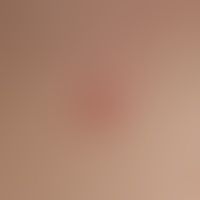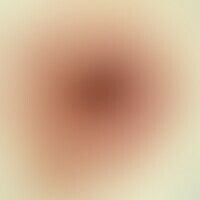
Acne conglobata L70.1
Acne conglobata: Con dition after extensive healing of an acute flare of acne conglobata; the aggregated, abscessed acne florescences are still recognizable by the red scars visible here.

Malasseziafolliculitis B36.8
Malasseziafolliculitis: follicle-bound, 2-6 mm large, inflammatory papules and papulopustules on the back of a 53-year-old female patient; secondary findings: melanocytic naevi and isolated seborrheic keratoses.

Dermatitis contact allergic L23.0
Acute contact allergic dermatitis with scattering reaction after application of a gel containing diclofenac; linear patterns (Koebner phenomenon) in the upper third of the dermatitis.

Pityriasis lichenoides chronica L41.1
Pityriasis lichenoides chronica: 19-year-old, otherwise healthy patient with a papular exanthema on the trunk which has been present for 1 year and runs intermittently. Hardly any itching. No other symptoms.

Parapsoriasis en plaques benign small foci L41.3
Parapsorisis en petites plaques: Non-symptomatic (no itching) red (hardly palpable), slightly scaly plaques, which have been inconsistent for years with improvement in the summer months or under UV therapy.

Pemphigus vulgaris L10.0
Pemphigus vulgaris. multiple, chronic, since 3 years intermittent, symmetric, trunk-accentuated, easily injured, flaccid, 0.2-3.0 cm large, red blisters confluent to larger, weeping and crusty areas. infestation of the oral mucosa.

Lyme borreliosis A69.2
Lyme borreliosis: L ate stage (stage III) with flat red spots and plaques all over the body; picture of generalized "acrodermatitis chronica atrophicans".

Pityriasis lichenoides (et varioliformis) acuta L41.0
Pityriasis lichenoides et varioliformis acuta. acutely occurring "colorful" exanthema after febrile infection with differently sized papules measuring 0.2-0.8 cm, papulovesicles, erosions, and encrusted ulcers. healing with formation of varioliform scars.

Dermatofibrosarcoma protuberans (overview) C44.-
Dermatofibrosarcoma protuberans. solitary, chronically dynamic, continuously growing for 4-5 years, poorly delimitable to the side and depth, woody solid, smooth, bumpy, red node. the lateral depth extension clearly exceeds the protuberant part (iceberg phenomenon).

Folliculitis profunda (overview) L01.0
Folliculitis profunda. acute, solitary, since 1 week existing, moderately sharply definable, firm, very pressure dolent, red, centrally ulcerated nodule (left mamma). distinct perilesional erythema.

Lymphangioma circumscriptum D18.1

Atrophy of the skin (overview)
Atrophy of the skin due to long term internal use of glucocorticoids; skin is paper thin and easily torn.

Pityriasis rosea L42
Pityriasis rosea. truncated, díchtes maculopapular exanthema arranged in the cleft lines, little itching.

Cutaneous t-cell lymphomas C84.8
Sézary syndrome. universal redness with severe itching that has existed for several years. generalized lymphadenopathy.

Keratosis benign lichenoid L85.91
Keratosis benigne lichenoide: Reddish plaque of about 1.0 cm on the upper side of the right mamma of a 79-year-old female patient. The patient had noticed relatively fast growth and therefore presented with malignancy. The tissue biopsy showed a lichenoid keratosis.

Transitory acantholytic dermatosis L11.1
Transitory acantholytic dermatosis. 6-8 weeks of slowly progressive moderately pruritic, truncal exanthema in a 53-year-old man. Red, 2-5 mm large, flat papules confluent at the sternum to plaques of about 3 cm diameter.

Tinea corporis B35.4
Tinea corporis. large, reddish-brownish, bordering flocks in the area of the back, fine-lamellar scaling, moderate itching (existing since 8 months).







